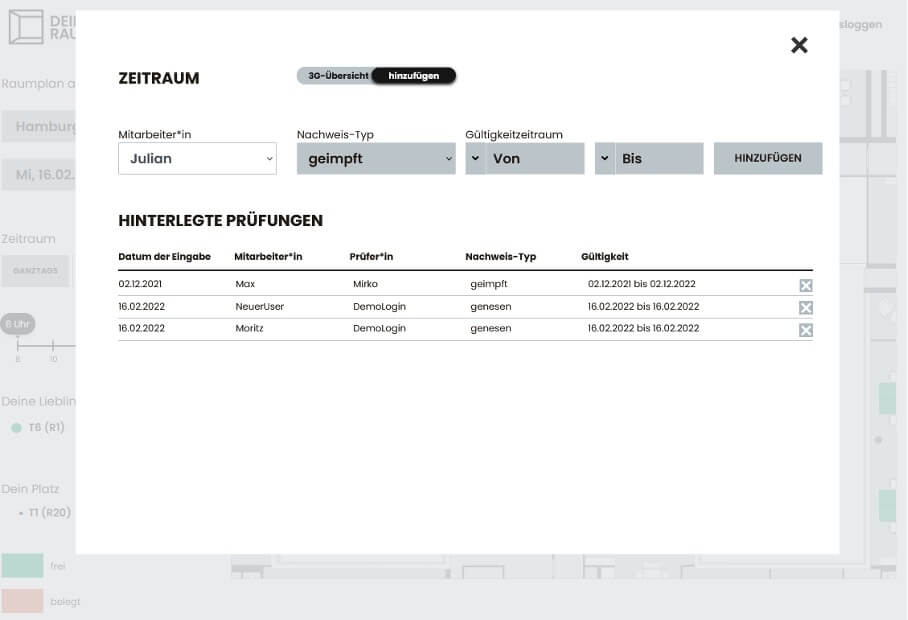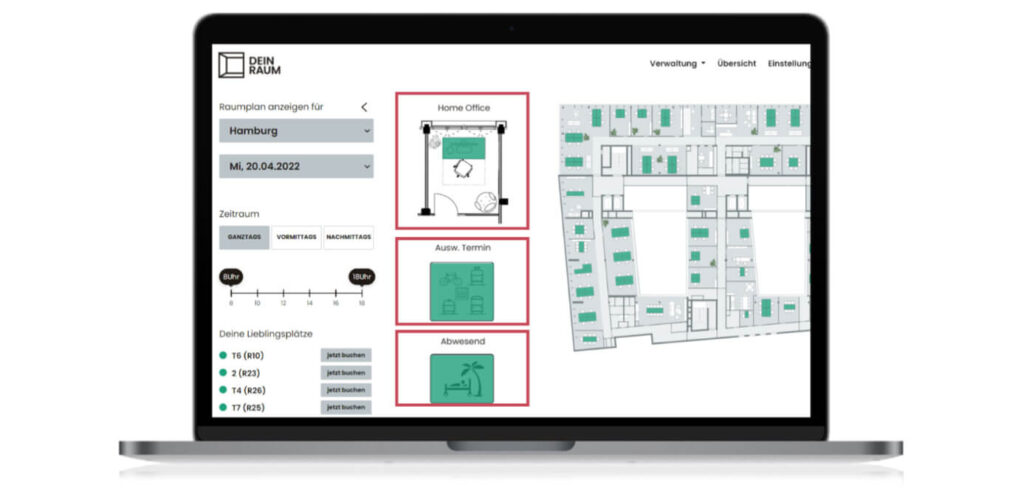Zuletzt aktualisiert am 5. April 2024 von Katja Hofmann
Checkliste zur Büroorganisation – Rückkehr ins Büro mit DEIN RAUM Desksharing
Die Pandemie erschwert die Rückkehr ins Büro enorm. Denn die Lage verändert sich nicht nur ständig, es erfordert auch einen durchdachten Plan, wie Mitarbeiter im Büro geschützt werden können. Dabei gilt es nicht nur bewährte Hygienemaßnahmen zu beachten, sondern auch der individuelle Weg zur Arbeit kann eine Rolle spielen. Um einen Überblick über die Anwesenheit im Büro zu haben und um diese im Sinne aller Beteiligten organisieren zu können, greifen immer mehr Arbeitgeber auf s.g. Desksharing Software zurück. Die Vorteile sind dabei vielfältig. Anbieter wie DEIN RAUM bringen nicht nur eine Funktion mit, über die eine Abstandsregelung am Arbeitsplatz kinderleicht organisiert werden kann oder eine Funktion zur Dokumentation der Einhaltung der 3G-Regelung, sondern bieten mit Funktionen zur Arbeitsplatzreservierung einen organisatorisch wertvollen Beitrag zur Einhaltung des Hygienekonzeptes und Abstandsregelungen. Infektionsketten lassen sich so erheblich besser vermeiden und Mitarbeiter schützen.
Am 19. März 2022 wurde die im Infektionsschutzgesetz verankerte allgemeine Homeofficepflicht aufgehoben. Für viele Unternehmen wird nun die Frage der Büroorganisation in der Pandemie neu gestellt. Um die Rückkehr ins Büro pandemie- und mitarbeitergerecht umzusetzen, haben wir im Folgenden Ideen, Tipps und Vorgaben zu einem Guide zusammengetragen und hoffen, dass dieser Euch die kommenden Aufgaben erleichtern wird.

Planung und vorbereitung der Mitarbeiterrückkehr
Das Arbeiten im Homeoffice empfinden Mitarbeiter: innen naturgemäß unterschiedlich. Für Einige ist es eine Erleichterung bei der Bewältigung des Alltags und Andere vermissen den sozialen Austausch im Büro mit den Kollegen oder stören sich an der räumlichen Vereinheitlichung von Arbeit und Privaten. Um allen Arbeitnehmern den Wiedereinstieg so angenehm wie möglich zu machen, empfiehlt es sich daher im Vorfeld eine Befragung durchzuführen und die Rückkehr anschließend stückweise umzusetzen.
Dabei hilft es festzustellen:
- Wer möchte wieder im Büro arbeiten?
- An wie vielen Wochentagen?
- Welche Voraussetzungen bestehen seitens Mitarbeiter: innen an eine Rückkehr ins Büro, um sich sicher zu fühlen?
Aus den erhobenen Daten kann im Anschluss eine Übersicht zusammengefasst werden, welche Vorstellungen bei den Mitarbeiter: innen vorhanden sind und welche Maßnahmen erwartet werden. Diese können dann mit den eigenen Vorstellungen und einem Hygienekonzept abgeglichen werden und ggbfs. auch um wertvolle Hinweise erweitert werden. Neben den Mitarbeiter: innen, die aus betrieblichen Gründen bisher nicht im Homeoffice arbeiten konnten, erhält man so auch eine Übersicht darüber, welche Mitarbeiter: innen bei einer stückweisen Rückkehr ins Büro, zuerst berücksichtigt werden können. Potenzielle Unstimmigkeiten im Team können so direkt vermieden werden. Darüber hinaus können Betriebsmannschaften gebildet werden, um sicherzustellen, dass kritische Positionen stets besetzt sind und um innerbetriebliche Personenkontakte zu reduzieren. Dabei hilft es festzustellen:
- Welche Fachkraftkapazität sollten jeweils immer vor Ort sein?
- Kann ein Rotationsprinzip für die unterschiedlichen Teams umgesetzt werden?
Das Hygienekonzept und Nutzungsregeln
Neben den Regeln zur Benutzung des Büros, ist ein durchdachtes und gut umgesetztes Hygienekonzept, das Kernstück zur Verminderung des Ansteckungsrisikos. Bevor das Büro also zur erhöhten Nutzung wieder freigegeben wird, sollten potenzielle Gefahrenspots identifiziert und ausreichend Desinfektionsmittel besorgt werden. Wir haben dazu folgende Guidelines erarbeitet:
Grundsätzliches
- Sicherstellung einer regelmäßigen Desinfizierung der Büroräume
- Sicherstellung des Mindestabstandes von 1,5m zwischen Personen
- Außerhalb des Schreibtisches sind FFP2-Masken zu tragen
- Sollte der Mindestabstand nicht eingehalten werden können, ist im Zweifel eine FFP2 Maske zu tragen
- Personen mit Atemwegs- oder Erkältungssymptomen bleiben zu Hause
- Falls möglich: Getrennte Ein- und Ausgänge einrichten
- Maximale Personenanzahl für Gebäude, Konferenzräume und Arbeitsräume ermitteln und kennzeichnen
- Regelmäßige Reinigung von Türklinken, Handläufen und Lichtschaltern
- Unterweisung der Mitarbeiter: innen über die Hygiene- und Abstandsregeln
- Aushang der Hygieneregeln im gesamten Gebäude
- Arbeitsmedizinische Vorsorge und Schutz besonders gefährdeter Personen
- Benennung eines Corona-Ansprechpartners
- Einhaltung der 3G-Regelung
- Regelmäßiges Lüften aller Räumlichkeiten
- Anschaffung von Luftwechslern für Räumlichkeiten die über keine Möglichkeit zur Lüftung verfügen
Eingangsbereich
- Gut sichtbar platzierter Desinfektionsmittelspender
- Bereitstellung von FFP2-Masken
- Bereitstellung von Desinfektionsmittel zur Mitnahme
Arbeitsräume und arbeitsplätze mit DeskSharing Software organisiren
- Maximale Personenanzahl pro Arbeitsraum ermitteln und kennzeichnen
- Vermeidung von Mehrfachbelegung von Räumen
- Bereitstellung von Desinfektions- und Reinigungsmittel im Arbeitsraum
- Regelmäßiges lüften
- Nutzung freier Raumkapazitäten
Konferenzräume
- Mitarbeitende halten Abstandsregeln ein
- Mitarbeitende tragen FFP2 Masken
- Markierungen kennzeichnen den Sitzplatzbereich
- Mitarbeitende lüften die Räume gründlich und bereinigen benutzte Bereiche
- Maximale Personenanzahl pro Konferenzraum ermitteln und kennzeichnen
Essbereiche und Aufenthaltsräume
- Bereitstellung von Desinfektionsmittelspendern
- Der Mindestabstand ist einzuhalten
- Markierungen zur Kennzeichnung von Sitz- und Essbereichen
- Bereitstellung von hautschonender Flüssigseife
- Bereitstellung von Einweghandschuhen
- Regelmäßige Desinfizierung und Reinigung der Sitz- und Essbereiche
- Umstellung auf Einweghandtücher zur Reinigung der Hände
- Erweiterung der Kantinen- und Essensausgabezeiten
- Maximale Personenanzahl ermitteln und kennzeichnen
Sanitärbereiche
- Gut sichtbare Hygiene-Guidelines zum Händewaschen
- Bereitstellung von hautschonender Flüssigseife
- Bereitstellung von Einweghandtüchern zur Reinigung der Hände
Arbeitswege
- Wie viele Mitarbeiter:innen nutzen die öffentlichen Verkehrsmittel für den Arbeitsweg?
- Können Alternativen wie Fahrrad- und Rollermietservices oder Carsharing angeboten werden?
Mit der Desksharing Software DEIN RAUM wird die Rückkehr ins Büro und die Organisation von hybriden Arbeitsmodellen zum Kinderspiel. Eine integrierte Funktion zur Gewährleistung von Abstandsregeln oder zur Dokumentation von 3G-Modellen, erheblich die Umsetzung von Hygienemodellen erheblich.
Mehr Information zu der DEIN RAUM Arbeitsplatzbuchungssoftware auf www.deinraum.io



